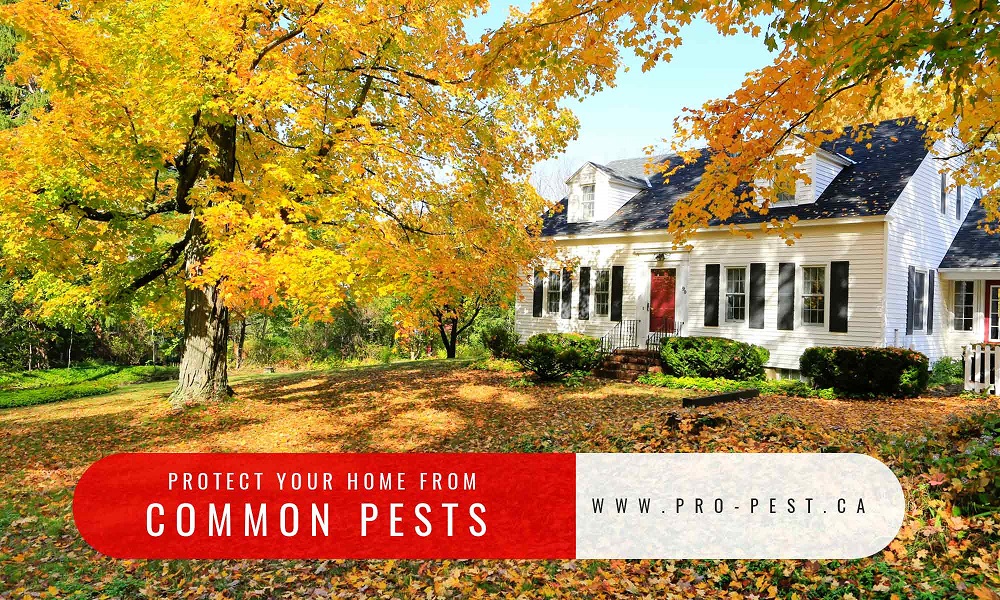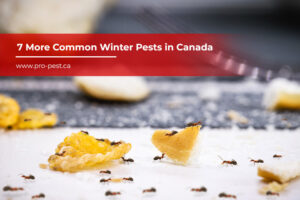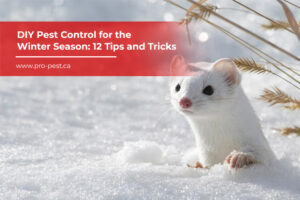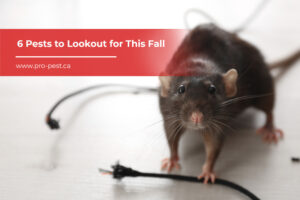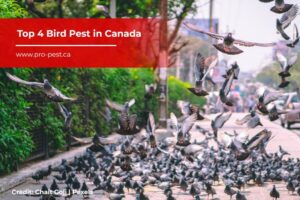Though the colder, autumn weather brings a relief from summer heat, it also brings an increased risk of common household pests invading (seeking warmth and protection). By knowing which pests may be most likely to take refuge in your home, you can take precautionary measures and be better prepared to ward them off.
Common Autumn Pests

Rodents
Rodents are warm-blooded animals, and need food and shelter to survive the winter. Their presence in your home can be extremely problematic for you and your family since they are known to:
- gnaw at open food
- carry and spread diseases (e.g. Lyme disease, Hantavirus, leptospirosis, rat-bite fever, and salmonellosis)
- nibble at wires (raising the risk of fire)
- damage furniture, clothing, and other possessions
- introduce parasites (e.g. fleas, ticks, and mites) which creates more issues
Some of the most common invasive species of rodents include:
- House Mice – House mice are named for their tendency to live and breed in homes (and other buildings), habitually getting into stored food and causing structural damage.
- Deer Mice – Deer mice are solitary creatures and their presence usually does not lead to large infestations. However, they are nocturnal and experts at hiding, making them difficult to track and remove.
- Norway Rats – Norway rats are a sociable breed and come in groups. If you see one, there are likely others nearby. They are also known for being ravenous eaters and will nibble their way through plastic if they must.
Evidence of an infestation:
- Droppings – Rodents leave all manner of droppings.
- Noises – Strange scratching and squeaking sounds in your walls or ceilings.
- Nests – Rodents often create nests made of twigs, paper, or chewed up fabric.
- Damage – Signs of gnawing on wires, books, or clothes or other damage like chewed up holes in walls.
To keep them out:
- Clean the area in and around your house.
- Use airtight containers when storing food.
- Find their access points and seal them with material they can’t gnaw through.
- Set up traps and arm them with bait. Peanut butter and other sweets are more effective than cheese.
- Call a professional pest control company for immediate removal of rodents from your property.
Flies

Flies search for sources of heat to secure their survival over the winter. Different species include:
- Cluster Flies – Cluster flies are named for their habit of forming clusters in homes or indoor spaces. Although they are not known to carry diseases that are life-threatening to humans, there are several reasons to keep them out of your home, including:
- they devour clothes and fabric
- they feast on furniture
- they can cause structural damage
- House Flies – House flies are commonly found in the home. They feed on filth and decay (including excrement) exposing them to various harmful pathogens, which can contaminate the food and living spaces in your home. They are known to carry at least 65 different diseases, including:
- Cholera
- E. coli bacteria
- Salmonella
- Tuberculosis
- Typhoid fever
- Fruit Flies – Similar to house flies, fruit flies gravitate toward areas with garbage and excrement. They also feast and lay their eggs on fruit and vegetables, contaminating any exposed produce in your household.
To keep them out:
- Clean every nook and cranny you think may become a breeding ground for flies.
- Keep waste and garbage properly sealed in bags.
- Place food in containers to keep flies from feeding and breeding.
- Call pest control professionals if the infestation becomes unmanageable.
Stinging Insects

Stinging insects can be dangerous. People who are allergic should be wary when they see these insects in and around their home. Allergic reactions can include redness, swelling (and sometimes difficulty breathing). The two main types of stinging insects to watch for during the fall season include:
- Bees – Near the end of summer, the queen bee leaves her nest in search of shelter for the winter. Queen bees are likely to take up residence in a warm and cozy environment (like the attic of a home). Bees can damage the integrity of wooden structures and expose residents to bee stings. These are a major problem for someone who may experience anaphylactic shock after a sting.
- Wasps – Wasps are known for being aggressive stingers so keeping them away from your home is wise. “Yellow jackets” are more aggressive in autumn so stay vigilant if you spot any, and cover food and sweet drinks if dining outside.
To keep them out:
- If you have a garden, grow plants that repel wasps (e.g. mint, thyme, and citronella).
- Seal any cracks and holes in your home’s exterior.
- Remove anything that may attract wasps (garbage and sweet-smelling food).
- Seal wood surfaces with paint.
- Hire the services of pest control experts.
Asian Lady Beetles

Though they may resemble the red and black, harmless ladybug, the presence of Asian lady beetles should not be taken lightly. Though they do not pose threats similar to those of disease-carrying creatures, they can be a nuisance. Lady beetles have a nasty bite, an unpleasant odour, and a penchant for travelling in large numbers. You may be tempted to crush them underfoot when you see them, but doing so will only add to the smell. Avoid them.
To keep them out:
- Seal gaps and cracks in windows, doors, and vents.
- Repair door and window screens that show any signs of damage.
- Sweep up insects or use a vacuum with a HEPA filter and empty your bag outside.
- Use ladybug traps.
- Seek the help of a professional pest control service to eliminate them from your home.
Stink Bugs

Stink bugs are relatively harmless, but they can bite. They are not poisonous, do not carry diseases, do not sting, or cause property damage. However, as their name suggests, stink bugs can create an unpleasant smell. When they feel threatened, they produce a smelly chemical in a gland on their abdomen. Some species can actually spray the chemical several inches. Another cause for concern is that a single stink bug can attract droves of others to your home, causing a persistent nuisance.
To keep them out:
- Seal entry points around door and window frames, electrical outlets, light switches, ceiling fans, skylights and ceiling light fixtures.
- Stink bugs are attracted to light, so change exterior lighting to less-attractive yellow bulbs or sodium vapor lights
Keep pests out of your home this Fall season. If the measures we describe don’t get the job done, call licensed rat and insect removers in your area.
For professional pest control in Toronto or North York, Pro-Pest is at your service. We offer humane pest proofing and wildlife removal services. Call us at (416) 487-4179.


